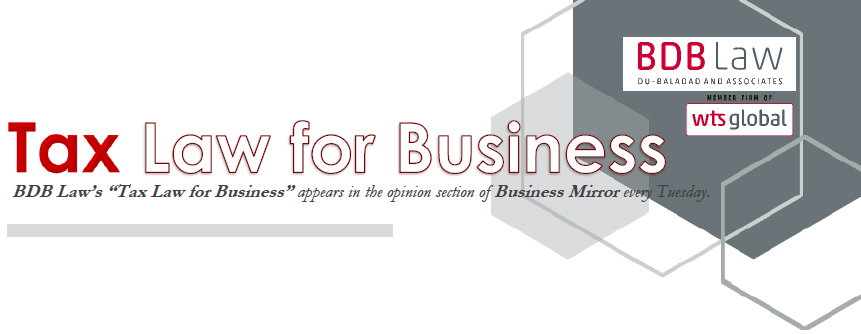Atty. Jomel N. Manaig, highlights the OECD’s Pillar Two and how it may affect the tax incentives offered in the Philippines.

OECD’s Pillar Two and the Tax Incentives
in the Philippines
By: Atty. Jomel N. Manaig
"If the OECD’s Pillar Two is concerned about taxing the ultimate parent entities in their home jurisdictions, should we be concerned? The answer is a veritable yes."
Is the Philippines ready for a looming international tax shakedown? How will we be affected? Do we even have the slightest clue of what is to come?
Base Erosion and Profit Shifting (BEPS) practices have been in the radar of several tax jurisdictions for quite some time now. Simply put, BEPS practices enable multinational entities (MNEs) to exploit gaps and mismatches between countries' tax systems. Tax havens and misaligned tax incentives immediately come to mind when BEPS practices are concerned. The concern is so prevalent that the Organization for Economic Cooperation and Development (OECD) stepped in and proposed a landmark Two Pillar approach to address these tax challenges.
 Pillar One provides market jurisdictions (i.e. jurisdictions in which consumers and users are located) a new taxing right over a portion of the residual profits of the largest and most profitable MNEs. On the other hand, Pillar Two is designed to ensure large MNEs pay a global minimum corporate tax of 15% on the income arising in each jurisdiction they operate.
Pillar One provides market jurisdictions (i.e. jurisdictions in which consumers and users are located) a new taxing right over a portion of the residual profits of the largest and most profitable MNEs. On the other hand, Pillar Two is designed to ensure large MNEs pay a global minimum corporate tax of 15% on the income arising in each jurisdiction they operate.
In this column, we’ll be focusing on Pillar Two and its potential effects to the tax incentive designs in the Philippines. To simplify, Pillar Two requires MNEs to compute the effective tax rate (ETR) for each jurisdiction it is operating or has subsidiaries in. Once that is determined, the tax authorities having jurisdiction over the ultimate parent entity of the MNE would impose a top-up tax which is the difference between the global minimum 15% corporate tax and the ETR for each of the other jurisdictions it is operating or has subsidiaries in. In other words, the ultimate parent entity would be paying additional top-up tax in its home jurisdiction should it be operating on other jurisdictions which have an ETR below the global minimum 15% tax rate. The lower the ETR is (relative to the global minimum 15% tax), the larger the top-up tax would be.
If the OECD’s Pillar Two is concerned about taxing the ultimate parent entities in their home jurisdictions, should we be concerned? The answer is a veritable yes.
Tax incentives are offered by jurisdictions, like the Philippines, to attract investments from foreign investors. While not being a tax haven, the jurisdictions offering these tax incentives more often than not include a substantially reduced income tax rate. With reference to Pillar Two, these tax incentives may affect the ETR.
For the better part of the past few years, our policymakers and lawmakers have been rationalizing our various tax incentives as part of the comprehensive tax reform program. The culmination of this effort is the CREATE Law. Our present tax incentives retained the income tax holiday and the 5% special corporate income tax (SCIT). Both these incentives essentially decrease the ETR to well below the global minimum 15% tax.
If an MNE is operating or has subsidiaries in the Philippines enjoying these tax incentives, their ultimate parent entity would be forced to pay an additional top-up tax in its home jurisdiction. If the ultimate parent entity would be paying the top-up tax in its home jurisdiction, then why should we be concerned?
Well, imagine if you will, the factors that an MNE consider whenever investing in a foreign country. One of these factors is the tax perks it may receive should it invest. All things being equal, the lower the taxes in a particular jurisdiction, the more attractive it is. If an MNE is forced to pay an additional top-up tax because it availed of the tax incentives of a foreign jurisdiction, then why even avail of the tax incentives? Why invest in the foreign jurisdiction if it will pay additional taxes in its home jurisdiction?
Looking at the Philippine perspective and assuming an ETR of around 5% (based on the 5% SCIT), the ultimate parents of the local subsidiaries would be forced to pay a top-up tax of around 10% in their home jurisdiction! The top-up tax greatly reduces the attractiveness of the SCIT, and by extension, the attractiveness of investing in the Philippines.
Another concern is the foregone tax collections. Remember that the top-up tax is paid at the home jurisdiction of the ultimate parent entity. Pillar Two of the OECD provides for mechanisms to have the top-up taxes collected by the jurisdiction where the subsidiaries are located. However, at least here in the Philippines, it would require legislation to impose the top-up tax. If there is no legislation, the top-up tax would go to the home jurisdiction of the ultimate parent entity.
The way Pillar Two is designed, the Philippine tax authorities may not even be aware that foreign jurisdictions (i.e. those having jurisdiction over the ultimate parent entities of the local subsidiaries) may be collecting taxes on income generated in the Philippines. Such foregone taxes could help boost our already struggling country.
Other countries, particularly the members of the OECD, are already making preliminary steps to implement Pillar Two. Although the Philippines is not a member of the OECD, it would still feel the effects of Pillar Two. The question now is when will we act to adapt to it?
The author is a junior partner of Du-Baladad and Associates Law Offices (BDB Law), a member-firm of WTS Global.
The article is for general information only and is not intended, nor should be construed as a substitute for tax, legal or financial advice on any specific matter. Applicability of this article to any actual or particular tax or legal issue should be supported therefore by a professional study or advice. If you have any comments or questions concerning the article, you may e-mail the author at This email address is being protected from spambots. You need JavaScript enabled to view it. or call 8403-2001 local 380.



